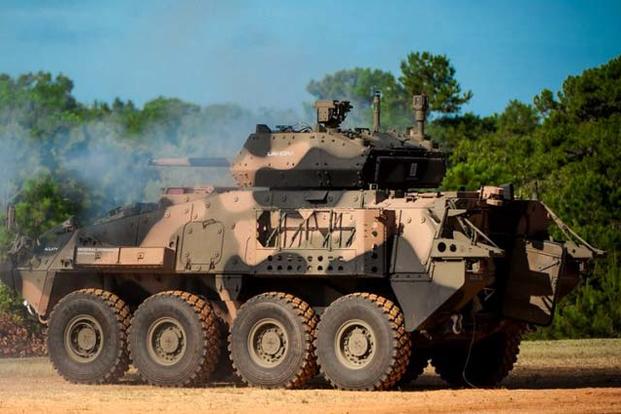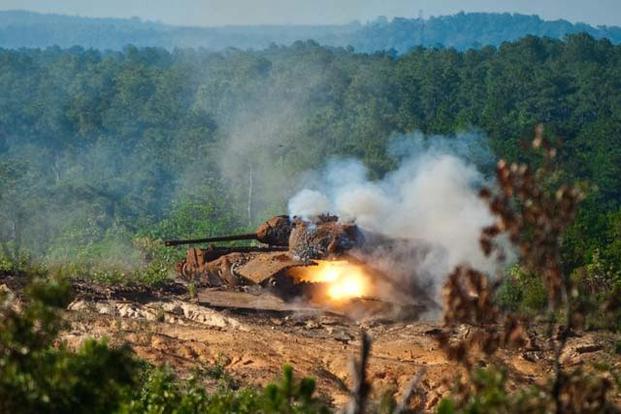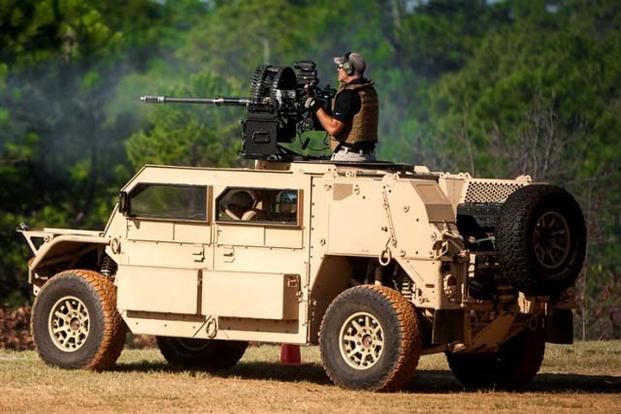Senior U.S. Army maneuver officials recently took part in a firepower demonstration of reconnaissance vehicle prototypes less than two months after the service killed the Light Reconnaissance Vehicle effort.
Lt. Gen. H.R. McMaster, along with leaders from the Maneuver Center of Excellence at Fort Benning, Georgia, attended the June 15 live-fire event at Benning's Red Cloud range to demonstrate the firepower potential of mounting 30mm cannons on different recon vehicle prototypes.
McMaster, director of the Army Capabilities Integration Center and deputy commanding general of Futures at Training and Doctrine Command, has been a strong supporter of equipping scout formations with a new Light Reconnaissance Vehicle since 2012.
The Capabilities Development and Integration Directorate Mounted Requirements Division at the Maneuver Center of Excellence teamed up with General Dynamics Corp.'s land and ordnance and tactical system units to host the demo.
The exercise featured the ground mobility vehicle 1.1 prototype firing the M230-LF 30mm cannon and the light armored vehicle combat reconnaissance vehicle prototype with a Kongsberg turret firing an integrated MK44 30mm cannon.
Related Video:
Army Live-Fire Demo of 30mm Vehicular Weapons
Both weapon systems are belt-fed and vehicle mounted. The M230-LF is identical to the cannon used on the AH-64 Apache attack helicopter, other than being belt-fed. And the MK44 is similar to the main gun on the Bradley Fighting Vehicle, but the Bradley's gun is chambered for 25mm.
Scouts need a specialized vehicle with enough firepower to destroy enemy recon formations, a point that McMaster continues to emphasize.
"To overmatch that enemy in those encounter actions, you need some firepower," McMaster told the audience after watching the devastating effects of 30mm ammunition on rusted-out tanks down range.
"We are facing threats, enemies and adversaries who have watched us very closely in recent years and have adapted their capabilities and developed new capabilities that have resulted in our forces in the future potentially losing our ability to overmatch the enemy in close combat."
McMaster and other leaders at the event said they hoped the demo would help drive more discussion on the need for specialty vehicles in the service's combat formations.
"This is an effort to invigorate and improve the capabilities of our reconnaissance formations and, in particular though, to make sure every Army formation has that appropriate combination of mobility, protection and lethality," McMaster said.
The Army quietly canceled its Light Reconnaissance Vehicle program in June, opting instead to equip cavalry scout units with the more general-purpose Joint Light Tactical Vehicle.
That decision came without notice after maneuver leaders held a two-week vehicle assessment at Benning last August involving six companies as part of a platform demonstration to evaluate prototypes from industry.
Instead, the Army will equip scout units in infantry brigade combat teams with JLTVs with potential sensor and lethality upgrades, officials maintain.
The service awarded Oshkosh Corp. a $6.7 billion contract last fall to build the first 17,000 production models of the JLTV. Both the Army and Marine Corps plan to buy a total of nearly 55,000 of the combat vehicles, including 49,100 for the Army and 5,500 for the Corps, to replace about a third of the Humvee fleets.
But maneuver officials maintain that the Army should not wait until the next major war to realize that its combat formations don't have the type of vehicles they need for the next fight.
"The inter-war period is critical because it is a time when you must leverage an opportunity to get ready for the next conflict," Maj. Gen. Eric Wesley, commanding general of the Maneuver Center of Excellence, told the audience. "And if you don't leverage that opportunity, you are frittering away a resource that has strategic implications."
Wesley also said that the Maneuver Center has a responsibility to show the Army leadership the types of vehicle platform programs that the service needs to field.
"We've got to make changes so that we are agile," he said. "We need to take on leadership in this role, and that is why we are doing this at Fort Benning, Georgia."
-- Matthew Cox can be reached at matthew.cox@military.com.





























